-
Car Reviews
- All reviews
- Midsize SUVs
- Small cars
- Utes
- Small SUVs
- Large SUVs
- Large cars
- Sports SUVs
- Sports cars
- Vans
Latest reviews
- Car News
-
Car Comparisons
Latest comparisons
- Chasing Deals
Kia’s fourth-generation Carnival has proven a critical and commercial success, and its new facelift polishes the package without meddling with the recipe
If Aussie car buyers don’t like people movers, then Kia’s Carnival clearly missed the memo. The eight-seater forged on when once-loved and respected nameplates such as Toyota Tarago and Honda Odyssey shuffled off their mortal coils, the Korean absorbing critical praise and commercial popularity in its current fourth generation.
The Carnival now enjoys around 80 percent share of mainstream MPV sales. The Kia leads by a country mile beyond the likes of the generally pricier Toyota Granvia and Volkswagen Multivan competitors whose genes are parked much closer to the commercial vehicle ranks.
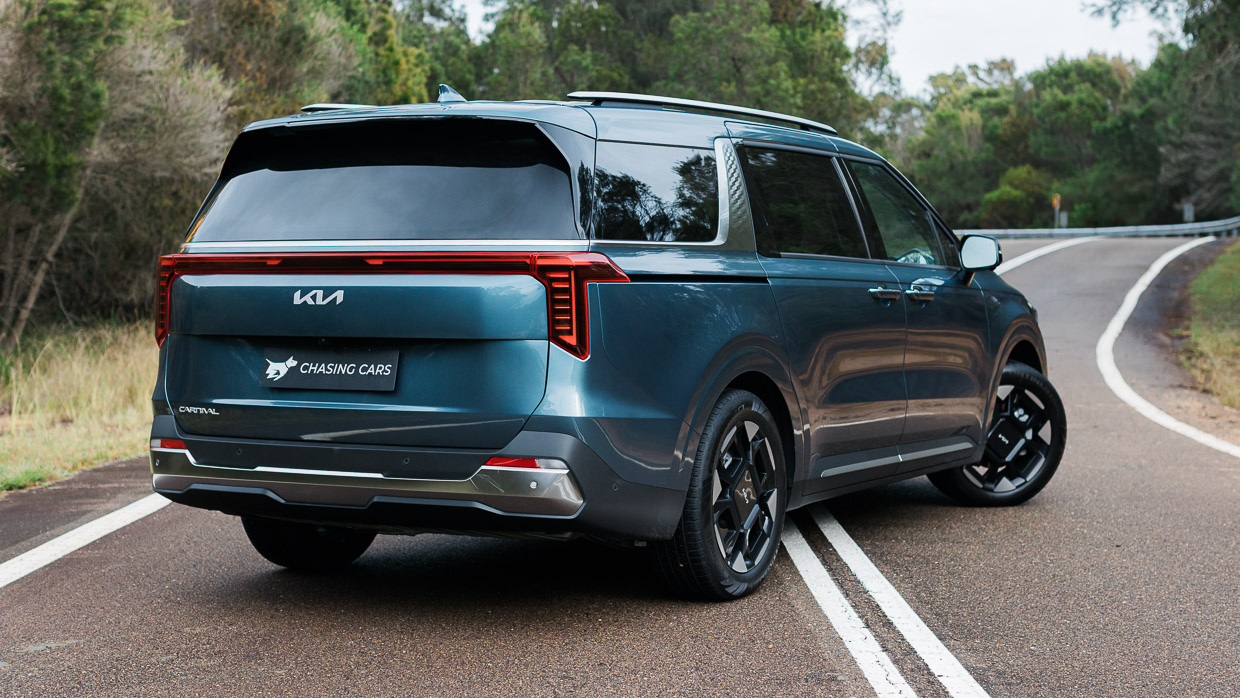
Yes, the mainstream people mover is a relatively small segment on the motoring landscape, but there’s also this: the outgoing ‘KA4’ Carnival was still back-ordered to the tune of 2000 units in Australia now that this new ‘KA4 PE’ facelifted version has just launched.
So while the eight-seat family hauler didn’t need a facelift to spur on popularity, it serves to address orders of today. A restyling ought to maintain freshness. The long-mooted curved digital display demanded an apt entry point. There was a turbo-petrol-electric hybrid to introduce. And Kia Australia felt compelled to ‘fix the suspension’.
The exterior design outed on the Kurdistan Automotive Blog – true story – is deftly executed, bringing a more contemporary look with considerable impact, styling that neatly bridges the language of existing ICE models with Kia’s arresting new EV aesthetic. And designers have done it with little more than remodelling the front and rear fascias.
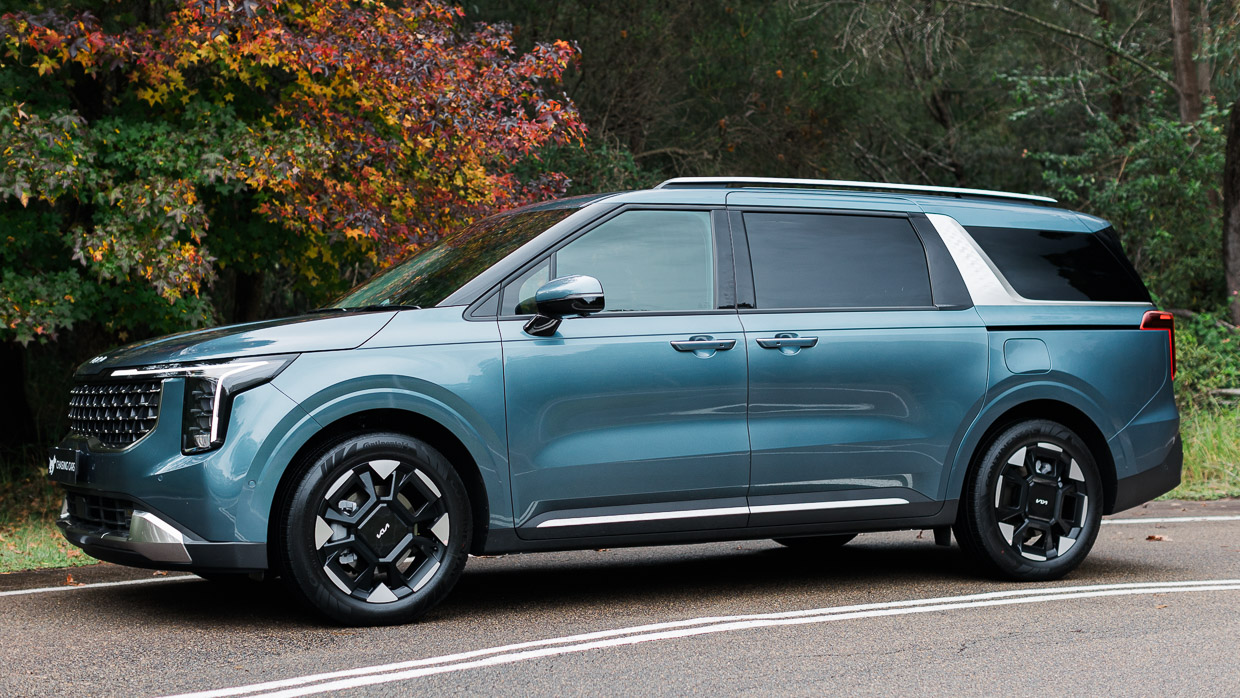
Ditto the interior. At first glance, the cabin looks slicker and more streamlined, though it’s largely due to the dual 12.3-inch digital widescreen window dressing and deft detail work, particularly the more straightforward HVAC interface, than it is broadstroke change. Of which there is little elsewhere.
As we’ve reported in the past, hybrid power has been a will-it-won’t-it prospect for Carnival, and largely because the petrol-electric versions are only produced in one plant globally, of which the Korean and North American markets get priority.
But the 1.6L Gamma II turbo petrol engine with closed-loop hybrid electric assistance has arrived in this facelift to join the evergreen, naturally aspirated petrol 3.5L V6s and turbo-diesel 2.2L fours carried over and unchanged from KA4.
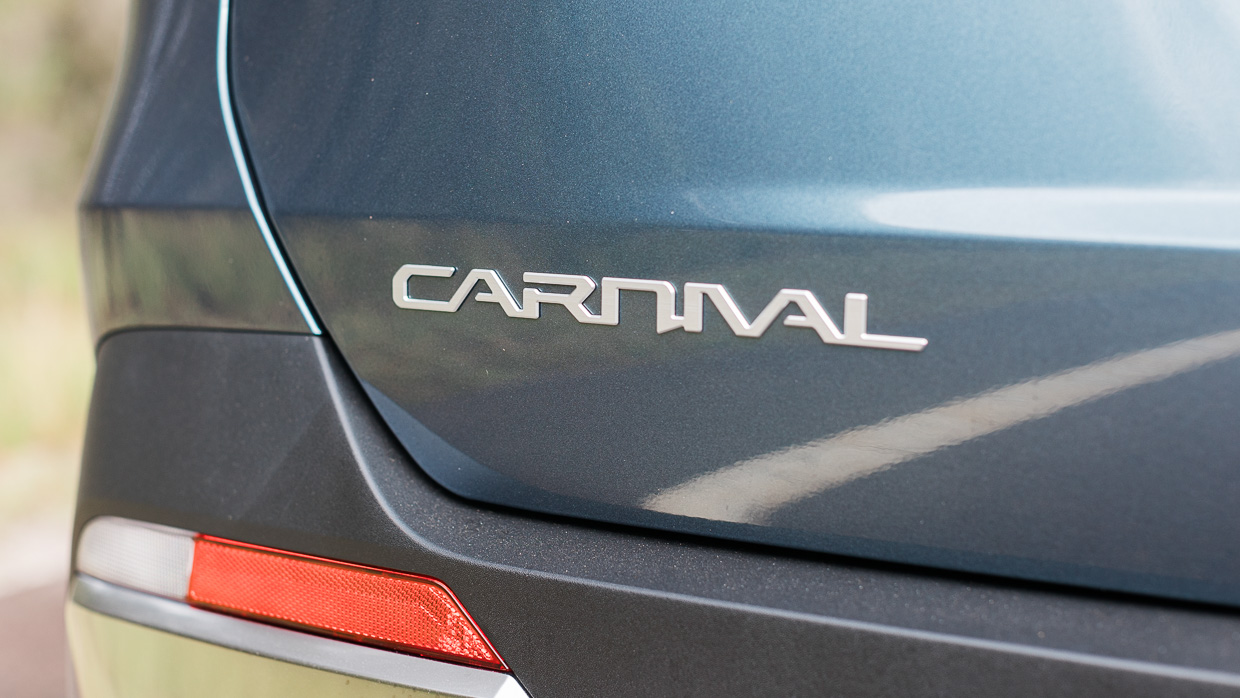
That’s the good news. The bad news is that limited supply – initially a 60-unit-per-month availability – reserves the fuel-sipping powertrain for the flagship GT-Line trim at a range-topping $76,210 list.
This is the same hybrid system Hyundai is using – more broadly and more prolifically – in the new Santa Fe. Reading between the lines, the sense is that, given customer satisfaction with the carryover powertrains, the hybrid will trickle down the Carnival variant hierarchy in good time, when supply opens up and when emissions regulations perhaps force it to.
Then there’s suspension. This facelift gave Kia Australia the opportunity to rid Carnival of “the last of the Covid” Korean-developed ride and handling tunes – to not so much fix the KA4 but, thanks to the R&D anchor that was the shutdown era, to actually develop suspension calibration it wanted.
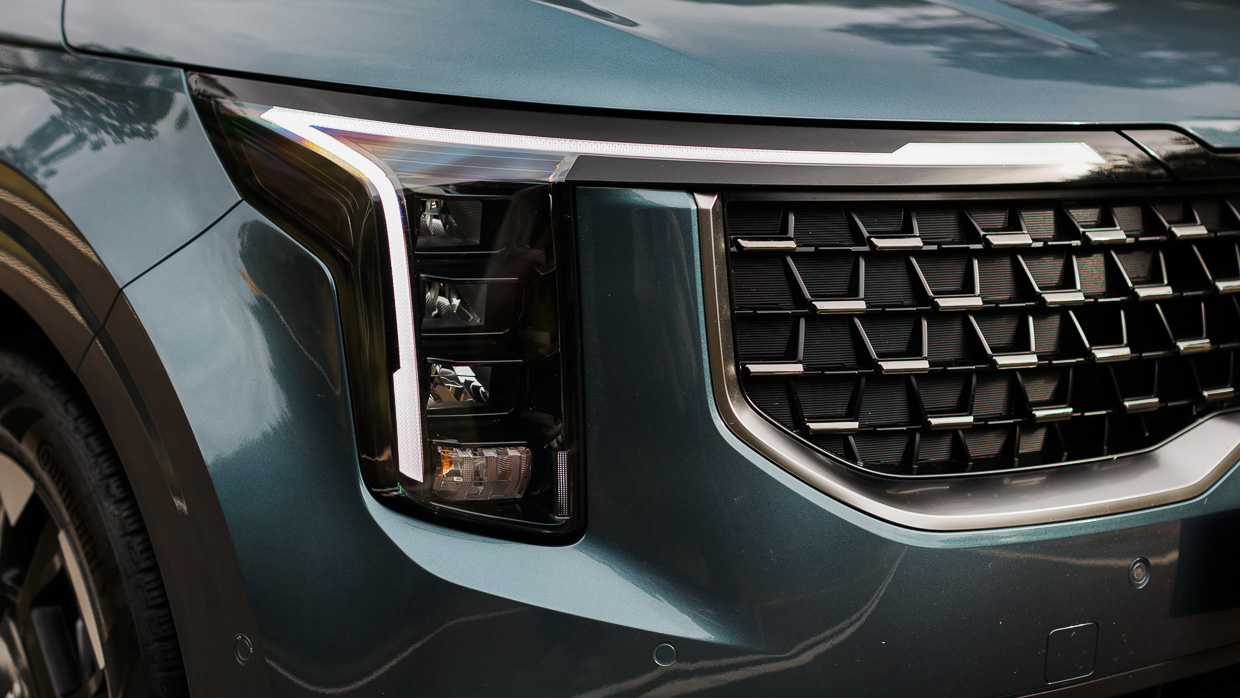
Yes, there are lashings of updates in the minutiae, mostly in tech, connectivity and safety, and all of it aiming to add polish to a model that is fundamentally carryover at its core with an unchanged recipe. Why meddle with success? Especially with areas such as Carnival’s already brilliant packaging.
Naming has had a shake up, “for simplification” says Kia Australia. The gradewalk now starts with the base S, before climbing up trim levels to Sport, Sport+, GT-Line Lite and, finally, GT-Line.
At the local Australian launch, we focussed our assessment on the flagship GT-Line in both V6 petrol and fout-pot diesel guises, as well as the new permanent trim level of GT-Line Lite with oiler power. The hybrid, absent from the program, will hopefully swing through the Chasing Cars garage in the coming months for review.
The 216kW/355Nm 3.5L petrol V6 is positioned as the lower-grade internal combustion choice, with the base S ($50,150) kicking the range off. This engine is also available in the Sport ($56,050), Sport+ ($62,380), GT-Line Lite ($66,350) and GT-Line ($70,680).
The 148kW/440Nm 2.2L diesel four is offered at a $2200 premium on each of the five available trim grades. Both carryover powertrains fit eight-speed torque converter automatics with front-wheel drive.
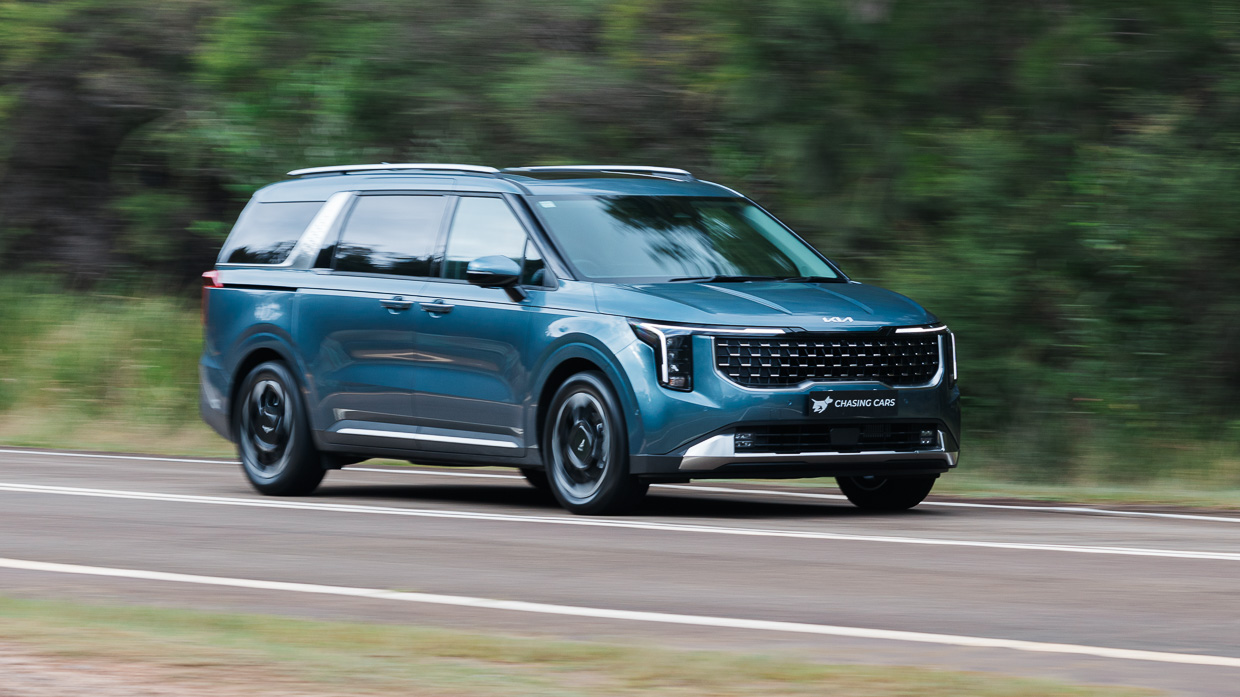
The sole petrol-electric variant is the tree-topping GT-Line Hybrid ($76,210). It combines a 132kW/266Nm 1.6L turbocharged petrol four married to a 54kW/304Nm electric motor – total system outputs are 180kW and 366Nm. It, too, is front-wheel drive, albeit adopting a six-speed automatic transmission.
The full grade walk can be found on our pricing and specs story, but the penultimate GT-Line Lite test here fits the following key specifications:
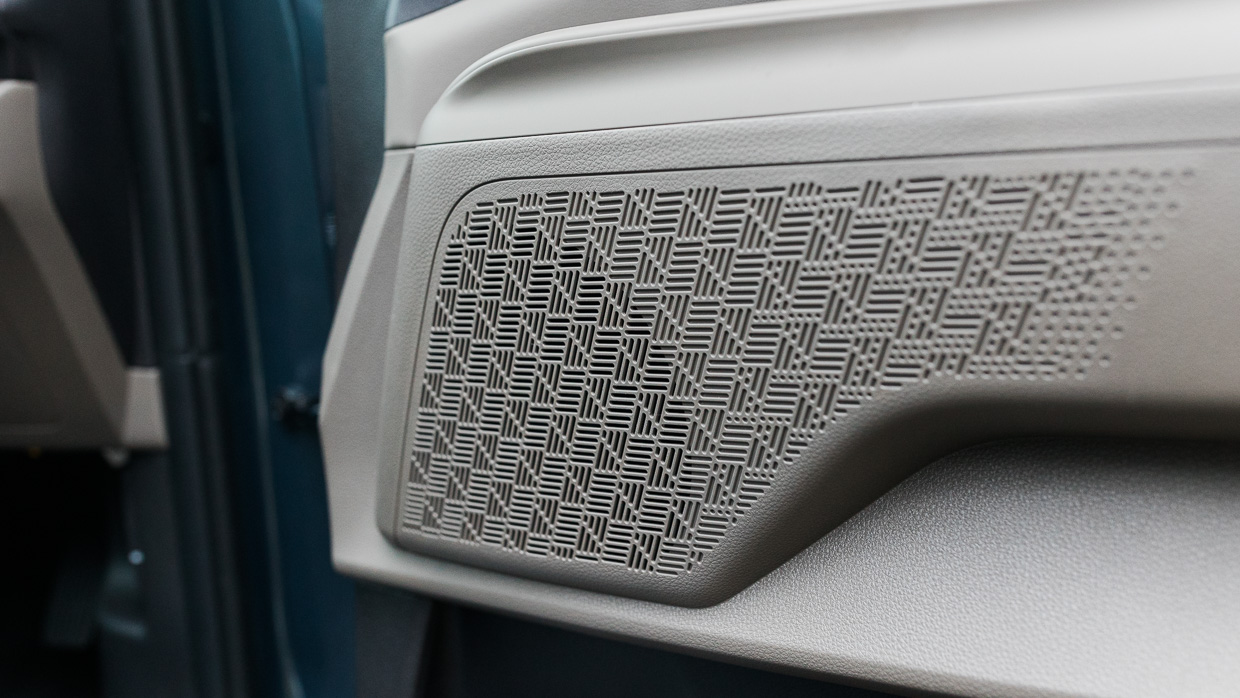
The flagship GT-Line adds the following features above the ‘Lite’ version:
Outside of integrated side steps ($1378) there are no options, per say, outside of accessories. Standard no-cost paint is Ceramic Grey, while any one of six premium hues commands an extra $695.
All variants fit a black and taupe two-tone interior colour scheme, cloth for the base S and artificial leather for all other variants.
Let’s face it: the finer nuances of how the Carnival drives aren’t likely to make or break the ownership deal in many buyers’ eyes. And, in general, the generally decent competency of the outgoing KA4 was fine enough to turn shoppers into owners, most of them in well regarded diesel.
Of the two engines, the oiler remains the pick of the carryover powertrains. We drove both the petrol V6 and the diesel four back to back across the same roads on the same day, and our advice is that the oiler’s extra $2200 outlay is worth the investment.
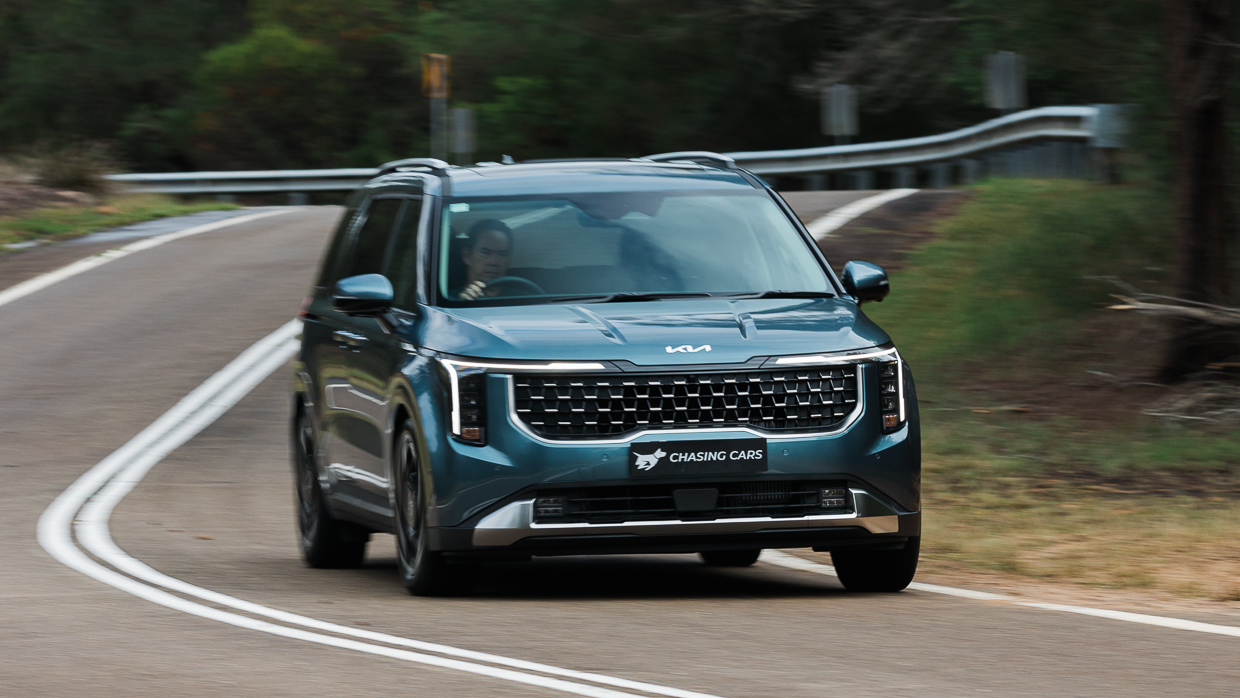
The V6 petrol is…fine. On the plus side, it’s quiet and an impressively smooth operator, and makes for polished pairing with the eight-speed auto. It’s flexible enough to keep planted in normal drive mode, adds expected response (and a touch of character) in sport mode, and does little wrong.
But the big petrol six does seem to work hard, even two-up and unladen, where 10.0L/100km consumption appears the norm. It’s most surely thristier, then, when loaded up with loved ones and luggage. Peak torque at 5000rpm isn’t that beneficial around town.
The diesel simply has more effortless shove in the low-to-mid-range, where you want it most of the time. Sure, it doesn’t rev out far, but as mated to eight forward speeds in the slick shifting auto it doesn’t need to.
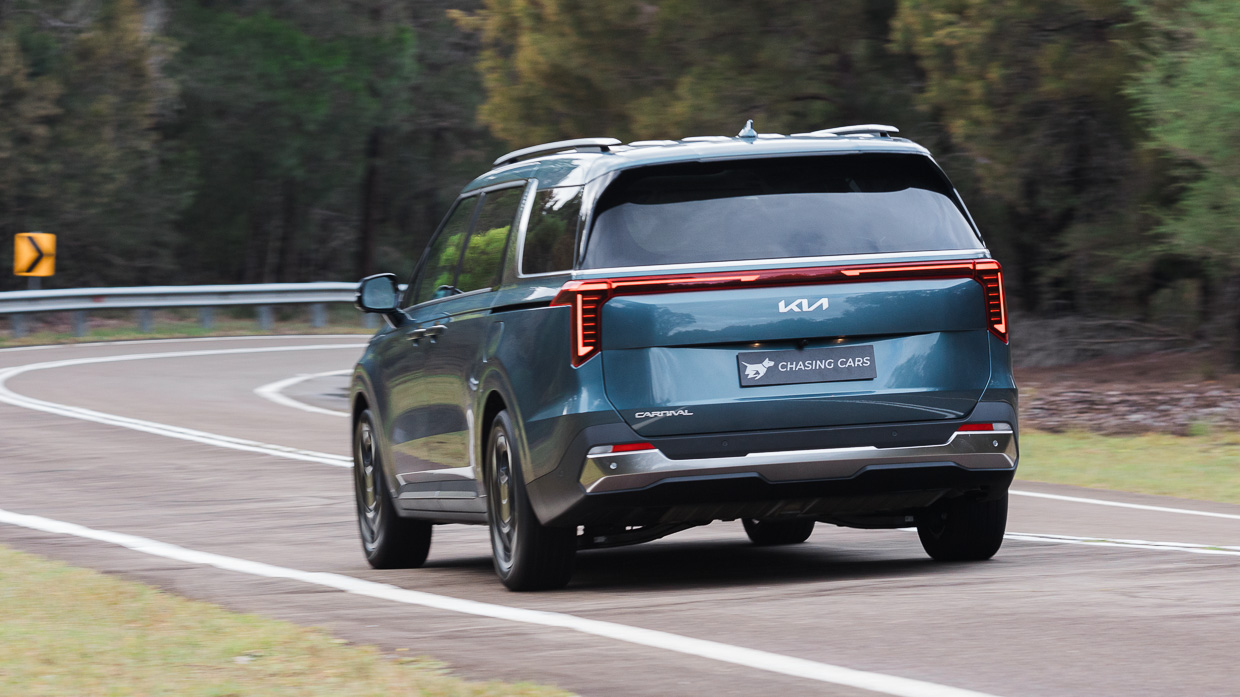
There is some faint diesel clatter, though the oiler is mostly a nicely refined unit that rides its 440Nm torque peak (from 1750rpm) comfortably enough, its unfussed manner returning a more frugal 7.0L/100km average compared with the V6.
On paper, the new hybrid ought to be the efficiency king, especially around town where its urban claim (4.2L) is less than a third of that of V6 (13.2L), while the diesel (7.8L) splits the pair on quoted town economy stats. Sadly, there were no hybrids to drive at the Carnival’s local launch…
Performance? At around nine seconds flat for the 0-100km/h sprint (one occupant and unladen), the diesel is no rocketship. Of course, nor is it expected to be. Still, the diesel does muster up enough energy to create some traction compromises under acceleration when the road surface is wet – such is the reality for this front-drive-only lineup…
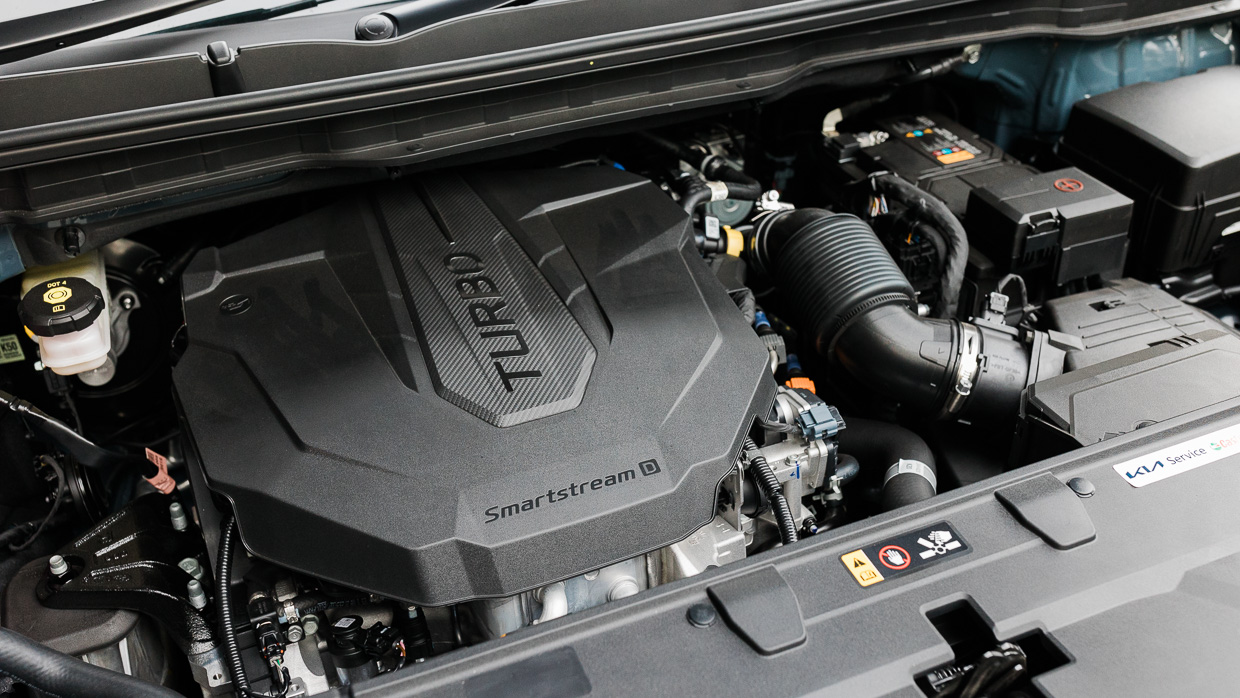
While there’s little news around the staple V6 and diesel powertrains, Kia Australia maintains the biggest change to the driving experience is in ride and handling.
The fourth generation Carnival debuted in 2021 with what Kia Australia now calls “the last of the Covid” suspension tunes in its local lineup. Three years ago, though, we reported company claims that some development was conducted before its Victorian chassis R&D crew pulled stumps due to lockdowns.
The prefacelift Carnival wasn’t bad but wasn’t great. Of the 2021 diesel Platinum we reviewed three years ago, we described the ride as compliant and cosseting, felt the (Korean spec) steering was fine if unremarkably vague and bereft of feedback, and noted the rear suspension was prone to thumping and undisciplined bounce.
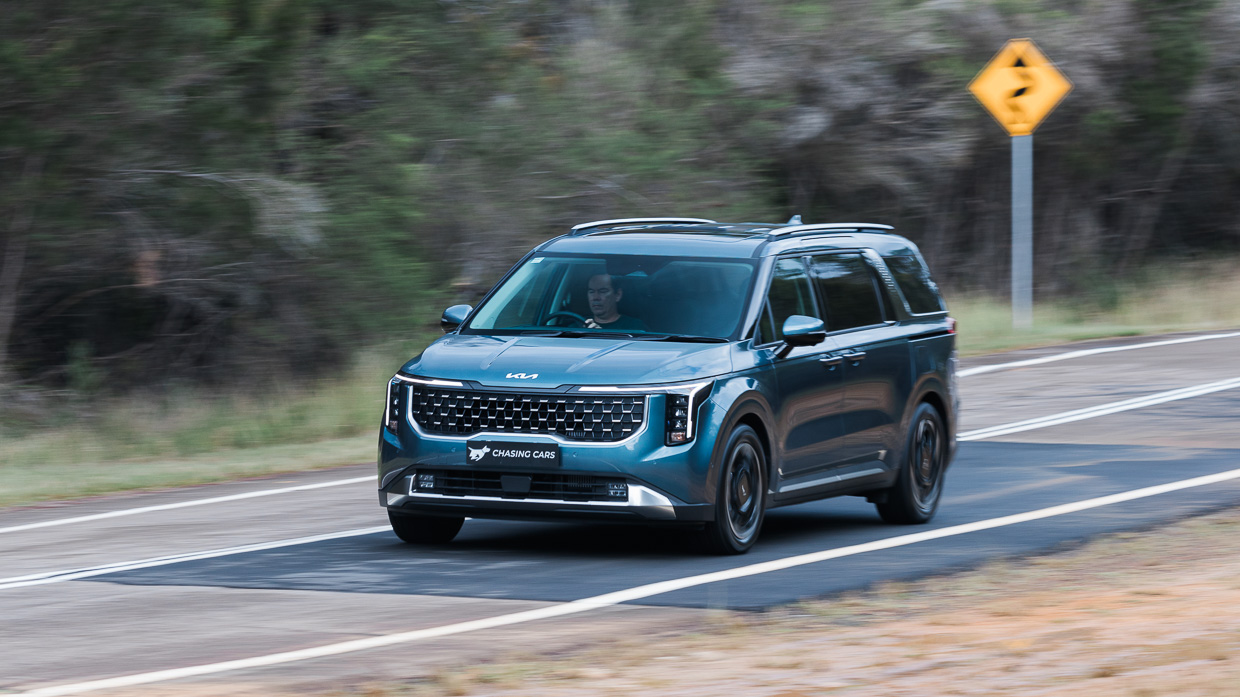
And now Kia Australia has invested in improvements where it felt that they were warranted.
Changes? The steering mapping was completely revised to the importer’s wants, the front spring rate was increased considerably, and the dampers were “upgraded” to frequency dependent valving, a technology that has previously migrated across other Kia model lines.
The tangible result is a ride and handling package that feels notably finessed though not necessarily transformed. Without back-to-back comparison old versus new, in situations ranging from one-up to fully loaded with eight occupants and luggage, it’s tough to discern to what degree improvements have been made.
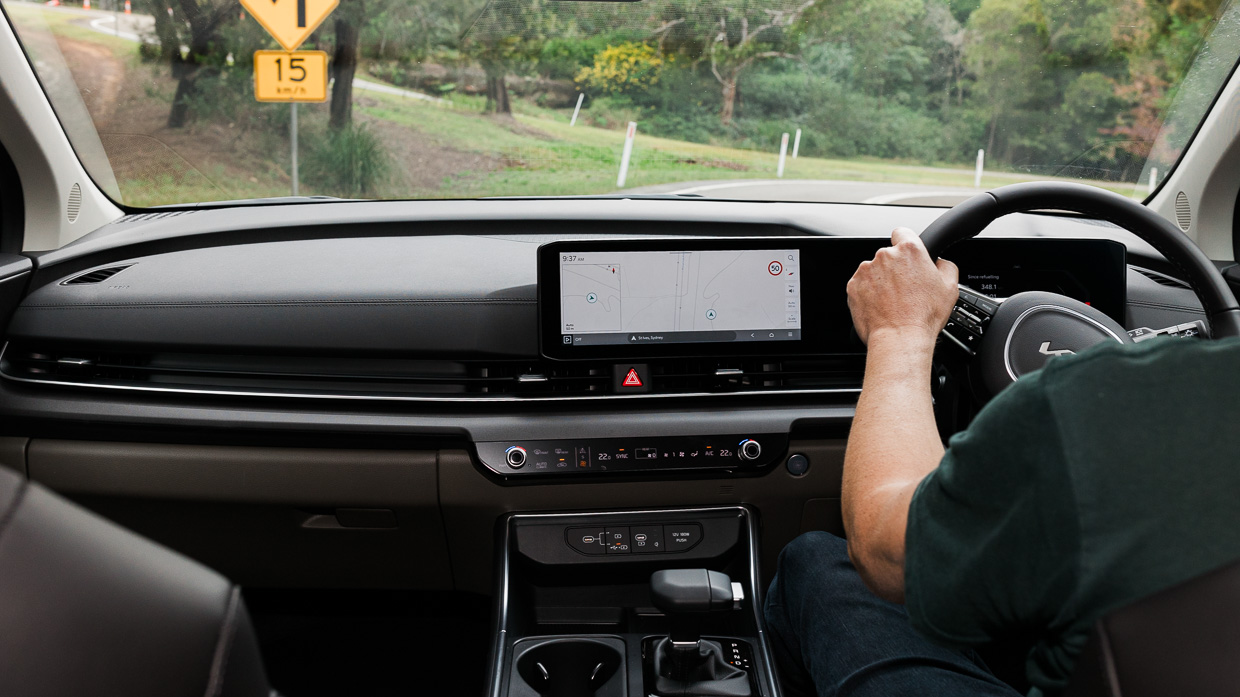
But Carnival feels a more polished drive. The steering is now as crisp and responsive as a five-plus-metre, 2.2-tonne, front-drive van might be, and in a lightweight mode with just two occupants it sits nice and flat in corners with minimum body roll. Be it a smooth highway or a lumpy back road, the people mover feels planted, surefooted and confident. More SUV-like than van-like, then.
The ride compliance is good, the resistance to noise, vibration and harshness seems nicely polished, and there’s a real underpinning quality to its manner. Jolting across bumps is kept to a minimum and there’s little sharpness in bump control.
What Kia hasn’t completely massaged out is the rear-end bounce. It’s much improved, but it seems that in injecting light-load compliance while still providing for heavy load (rear end) support, a degree of compromise has been struck.
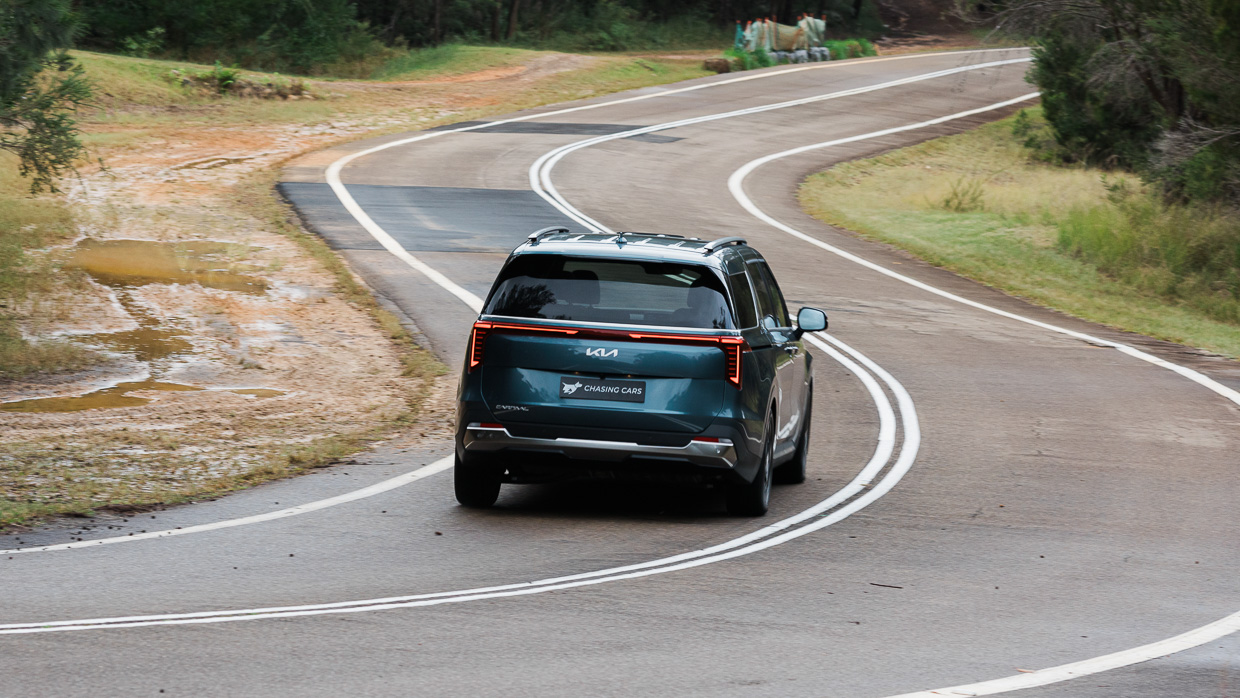
As Carnival isn’t sold in Europe there was no compulsion to fit a driver attention monitor system and, as a result, the Carnival omits the one ‘assistance’ system that’s fast becoming a deal-breaking annoyance for many new releases, particularly many from Korea and China. Still, it’s not without systems that’ll make your blood pressure rise…
The camera-based overspeed detection system infuriates, but it’s easily switched off even if, annoyingly, it’s demanded after every restart. The lane departure warning system, which activates at quite low speeds, is similarly easy to defeat. The long, drawn-out, speed camera and school zone warning massaging, though, will seriously test your patience in ownership.
Having spent equal seat time in both the GT-Line and slightly more affordable GT-Line Lite, it’s evident that there’s very little that separates the two on road. The flagship gets a neat muti-functional colour head-up display that’s handy, though the digital rear-view mirror – that forces excess driver attention to appropriately judge depth perception – is a hard pass for your reviewer.
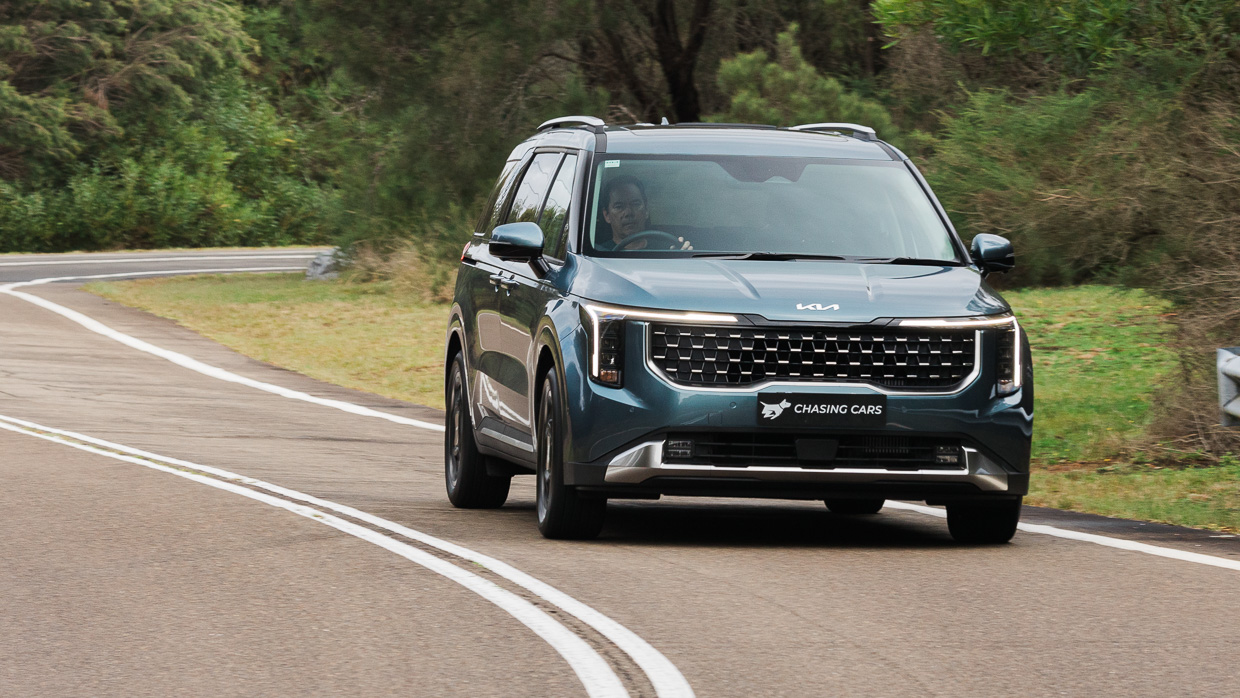
Both get the blind-spot view monitor system, the camera-based in-dash rear-view assistance, which users will tend to like and use or loathe and won’t – your reviewer’s in the latter camp. However, each gets a wonderful 360-degree surround camera system that makes parking and maneuvering in tight space a doddle.
The flagship is also the only version fitting the by-wire rotary transmission selector. It’s fine, but the more conventional ‘mechanical slot’ shifter of the GT-Line Lite, and all variants below it, is a quicker and more intuitive design to use.
Doors. Even before we get to the interior fitout, it’s worth noting how practical the conventional front door and electric sliding side door arrangement is, especially for rear passenger entry and egress in tight car spaces given the Carnival’s near two-metre width. The electric tailgate, too, lifts in a much more concise arc than that of Hyundai’s Staria.
The cabin look and feel doesn’t fall from the pre-facelift Carnival, though it’s a little cleaner and simpler thanks to a few key tweaks.
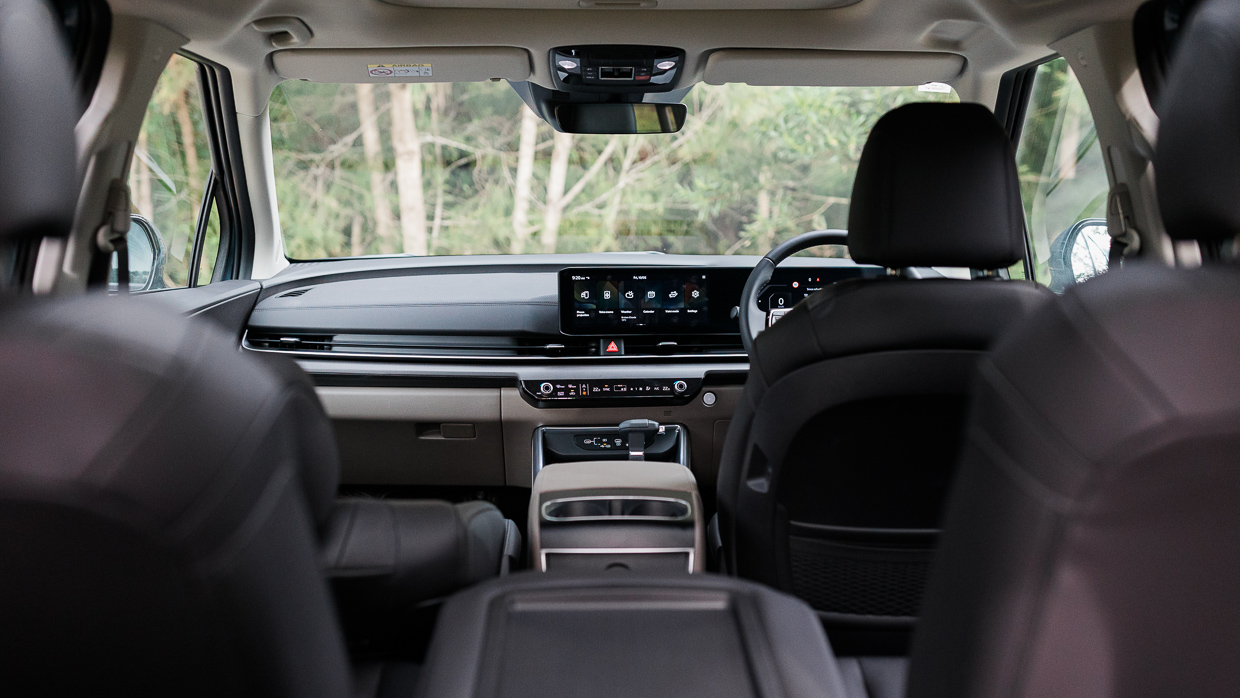
The key update is a long-awaited curved display screen that integrates dual 12.3-inch displays, one for the driver display and other for touchscreen media interaction. The widescreen format is fitted from the mid-spec Sport+ variant and up – the base S and Sport versions fit the 12.3 media screen married to a ‘basic’ digital screen integrating a 4.0-inch LCD display.
Carnival now fits Kia’s latest Connected Car Navigation Cockpit (ccNc) platform seen in the electric EV9 and Sorento, complete with a quite intuitive menu system with trendy pinch, zoom and swiping trickery and a gamut of remote party tricks you can control via your smartphone.
Some features, such as remote engine start, are available across all grades. Others, such as Remote Smart Parking Assist – where the vehicle can be remotely moved via phone from tight parking spaces – are reserved for the higher or highest trims. You can also precondition the climate control or control window operation remotely for most variants.
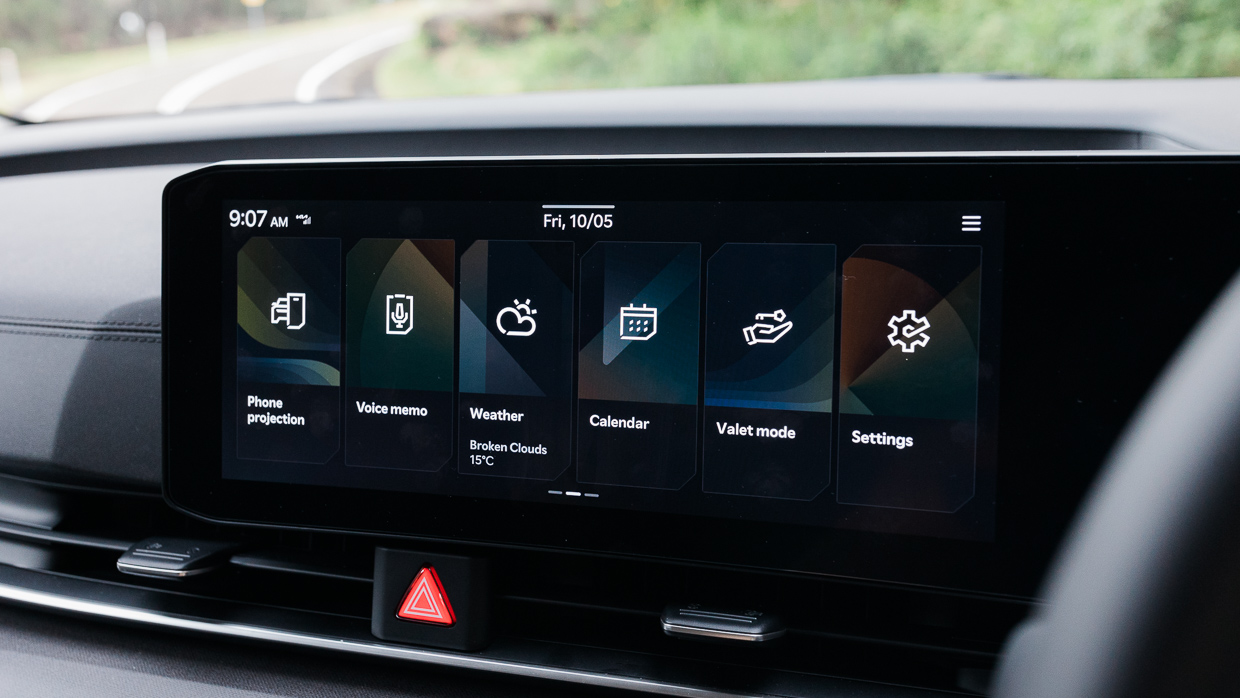
Add the aforementioned blind spot view monitoring (most variants) together with the whiz-bang head-up and digital rear-view mirror (GT-Line only) and it’s clear the lion share of facelift cabin changes are funnelled into tech upgrades.
Elsewhere, both Apple CarPlay and Android Auto are wireless or wired – your choice – feature across the board, as does natural voice recognition and over-the-air system updates. You really have to drop down to the base S to lose features such as DAB+ and sat-nav.
The HVAC system, which is dual-zone front and single rear climate control on Sport+ and up, has a new streamlined interface with dedicated temperature dials, which also keeps the dash fascia presentation neat and simple. Rear climate is controlled via the main panel, or via a neat satellite control unit in the second row ceiling.
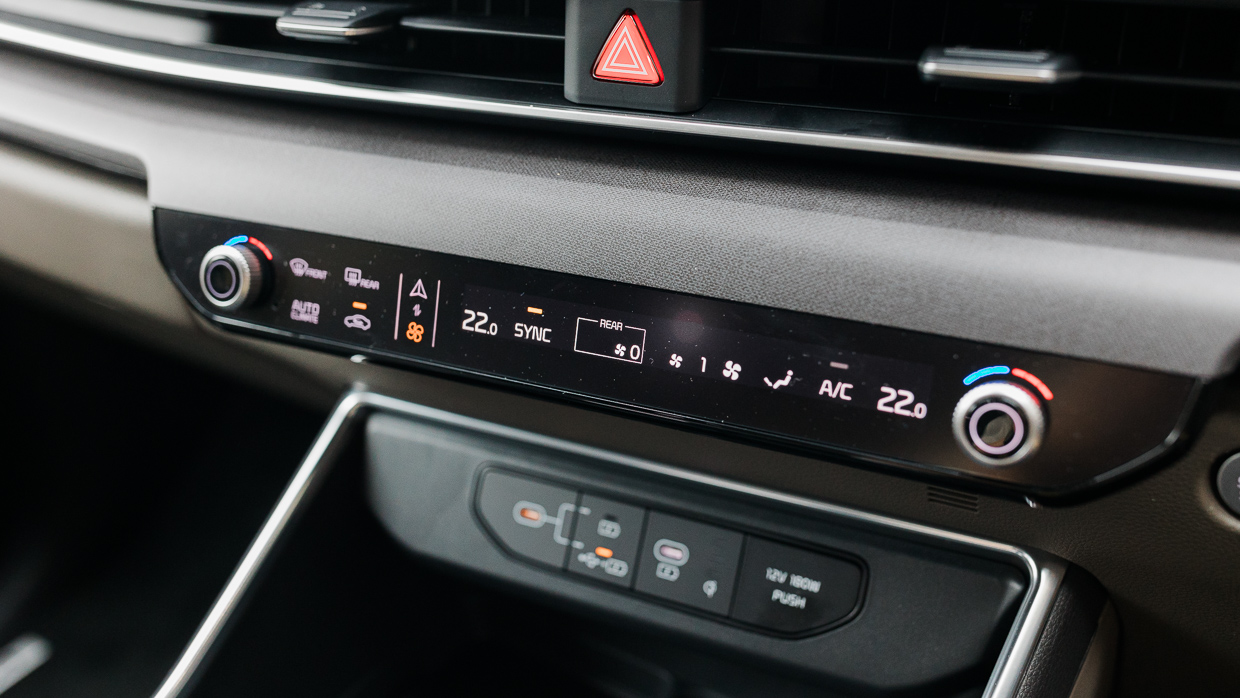
Black and taupe two-tone is the only theme offered in Carnival – cloth for base, fake leather for the four higher grades that feature ‘premium seats’. It’s a matrix array of seat options paired with variant grades though, interestingly, I find the 10-way-adjustable ‘Lite’ driver’s seat comfier than the flat-backed 12-way-adjustable GT-Line pew.
Perhaps the big disappointment is that, by and large, the interior seating and the trim is largely indistinguishable from the Sport up through to the GT-Line across all four grades. The flagship really deserves more upmarket and distinctive seat trimming.
Elsewhere, the first row is leisurely, airy and festooned with oversized storage – a double phone tray with single inductive charging, large cup holders, and generously sized console and door bins.
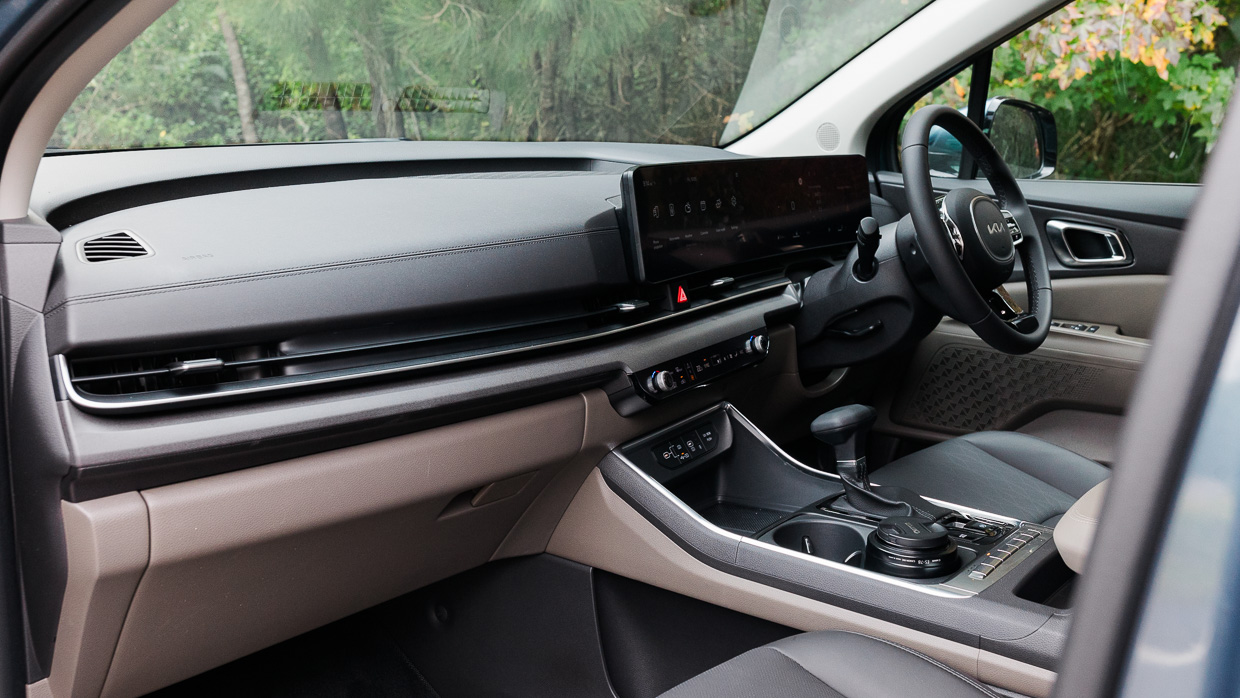
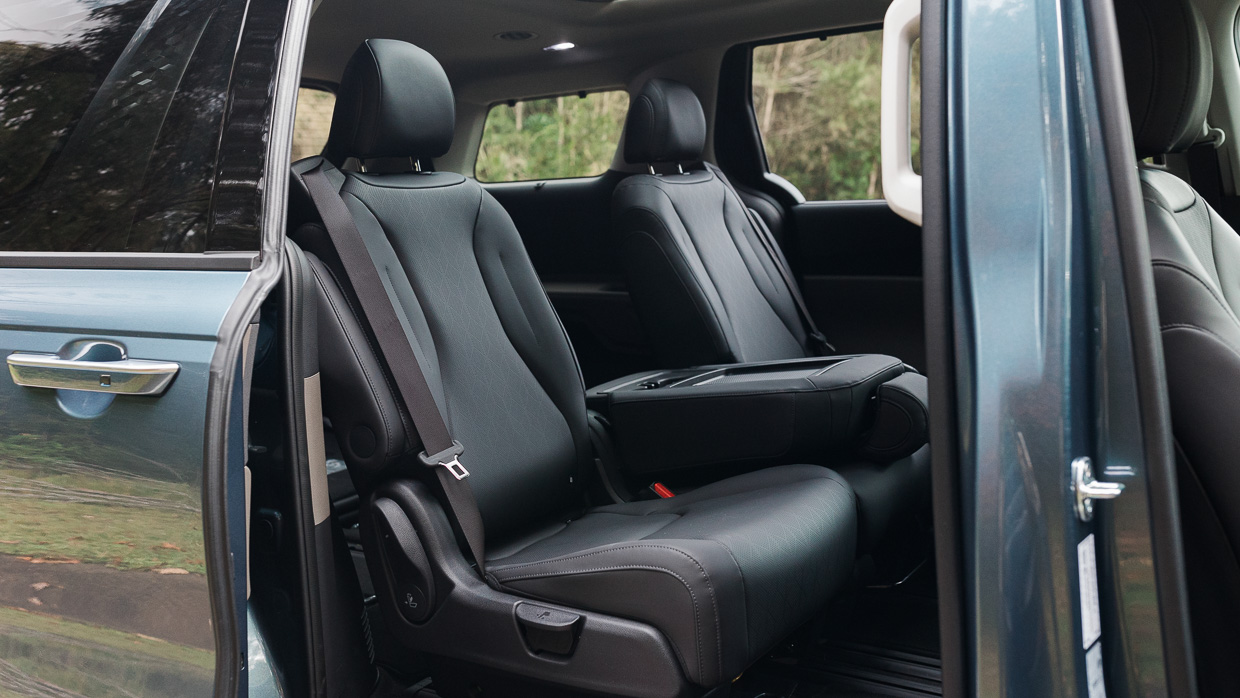
Row two is proper Swiss army accommodation. The rear bench has outboard bucket seating with slide and tilt adjustment, while the centre position can be dropped to create a huge armrest with additional cup holders, reversed for rear-facing seating or even removed completely.
It’s all very clever and very cool, and all featured right throughout the range.
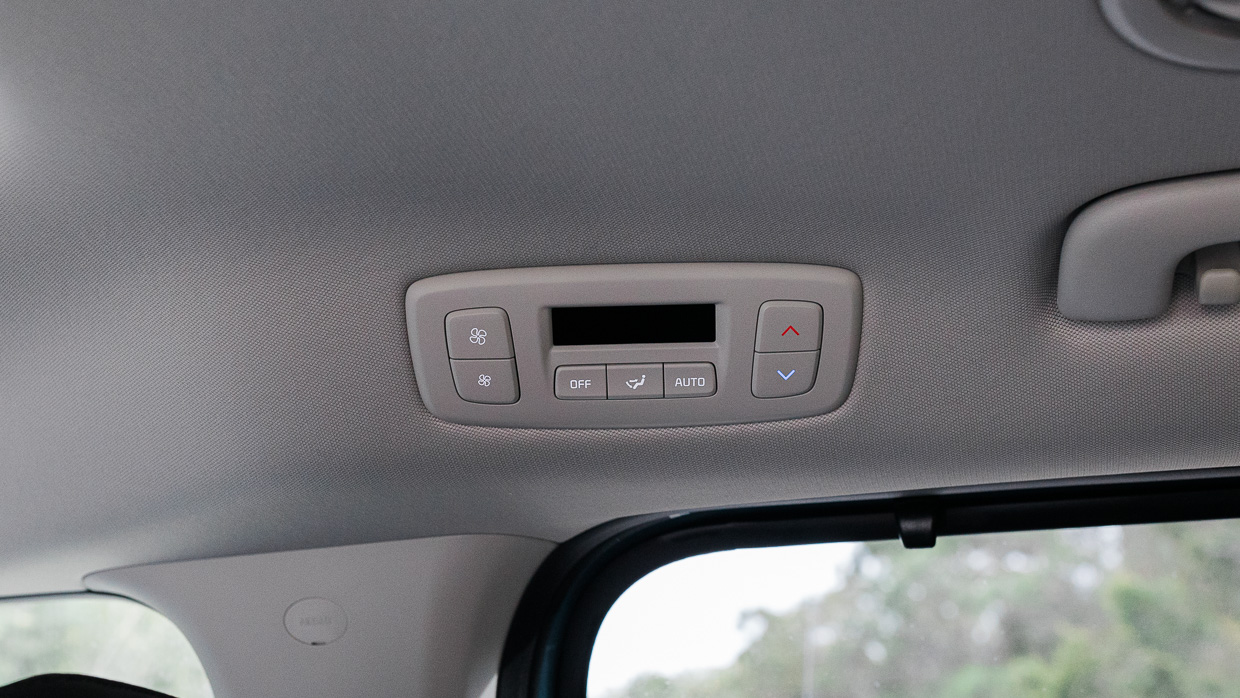
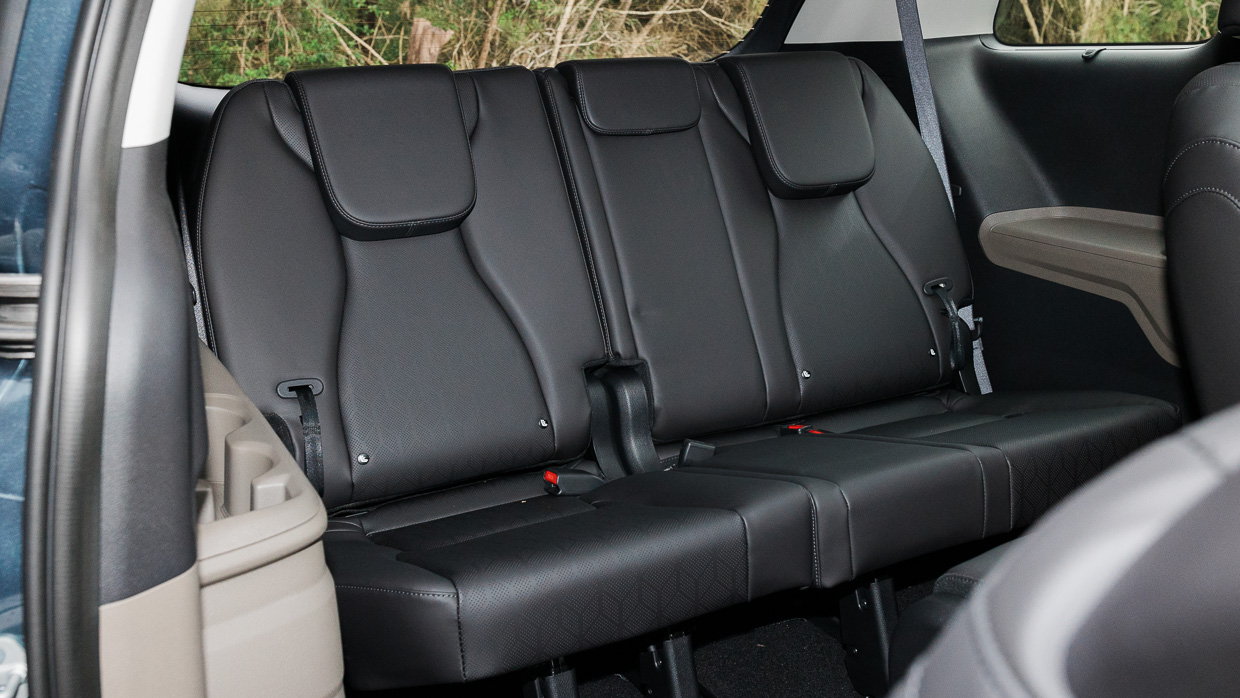
Air vents in the ceiling and USB-C outlets (in the sides of the front seats) are accounted for, and both are also offered in the third row as well. Rearmost access is actually easy kerb-side given the generous entry clearance, though the third row is practically a two-adult affair with relative comfort or three kids at a pinch.
The Carnival is genuinely a proper three-row adult proposition, and it’ll fit six adults with reasonable long-haul comfort. Rearmost headroom is much more constricted than in the second row, which features the rear sunroof glass, but ultimately something has to give.
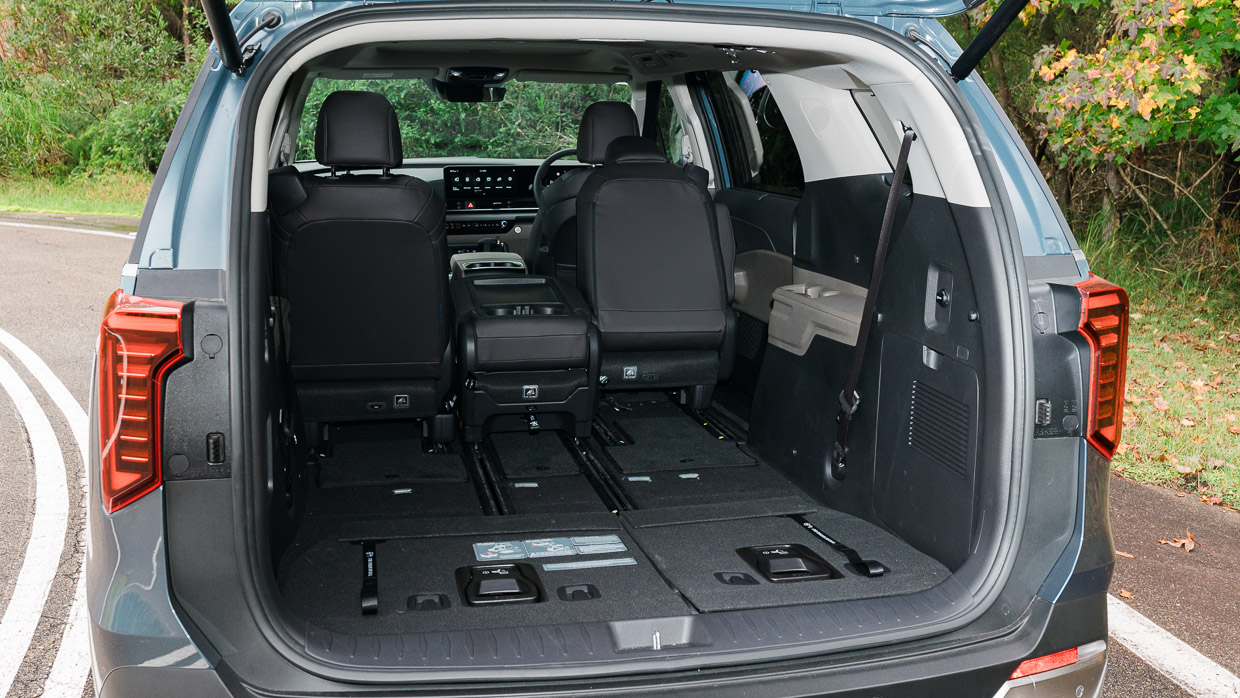 |
|
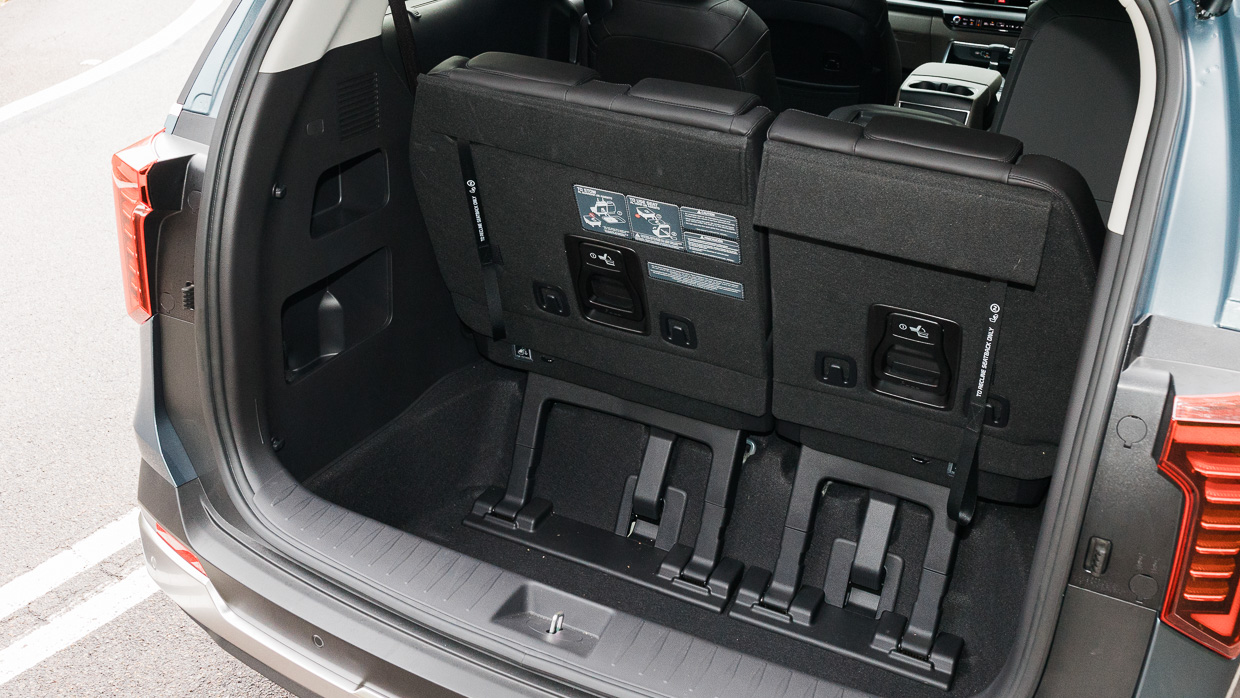
Remarkable is that even with all seats in play, the Carnival still offers a claimed 627L of boot space, much of it thanks to the bathtub-like cavity in the floor that serves to stow the third row seating, leaving a nice flat load space for luggage (and a whopping 2827L of claimed volume).
We’ve said it before and we’ll say it again: the Carnival’s packaging is utterly brilliant.
On paper, the facelifted Carnival features more safety than when its forebear was awarded five stars by ANCAP back in 2021, a rating that carries over to the new lineup.
A front centre airbag – now a total of ten – as well as rear collision avoidance, blind spot view monitoring camera tech, junction crossing/oncoming lane change AEB, and two grades of Highway Driving Assist – the higher version offering automated lane changing at the touch of an indicator – are all additions over the previous specifications, though fitment is variant dependent.
Otherwise, standard safety inclusions on all variants are:
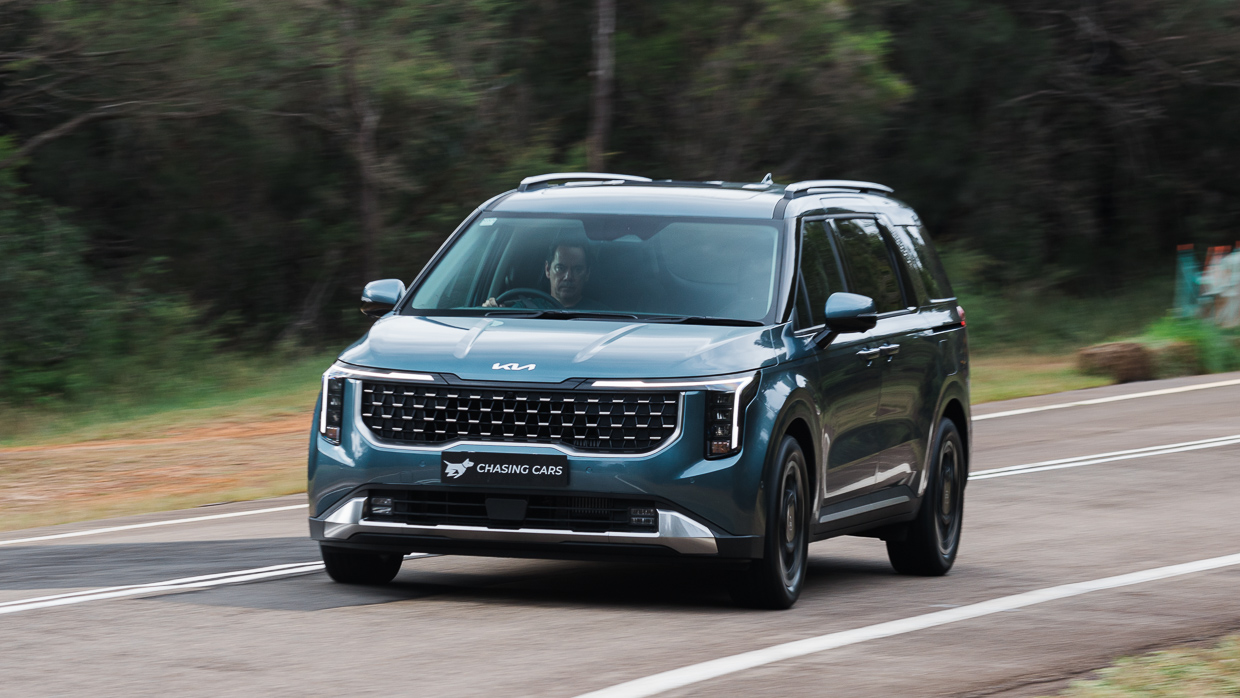
From Sport+ up fitment includes:
During assessment, we found the camera-based overspeed detection less than completely accurate and that the lane following feature intervenes too eagerly during low-speed backstreet driving, though both are easily defeatable. We also found the speed camera and school zone warning features to be excessive and overbearing at times.
The Carnival is covered by Kia’s excellent seven-year, unlimited-kilometre warranty. Up to eight years of complementary roadside assist is offered if you service the vehicle with Kia in accordance with the servicing terms.
Those terms are 12 months or 15,000km between visits for Carnivals powered by the 3.5L petrol or 2.2L diesel. While Kia has not released updated capped price servicing for the KA4 PE facelift, pricing for the MY23 KA4 with identical running gear runs at around $2600 for five years of servicing.
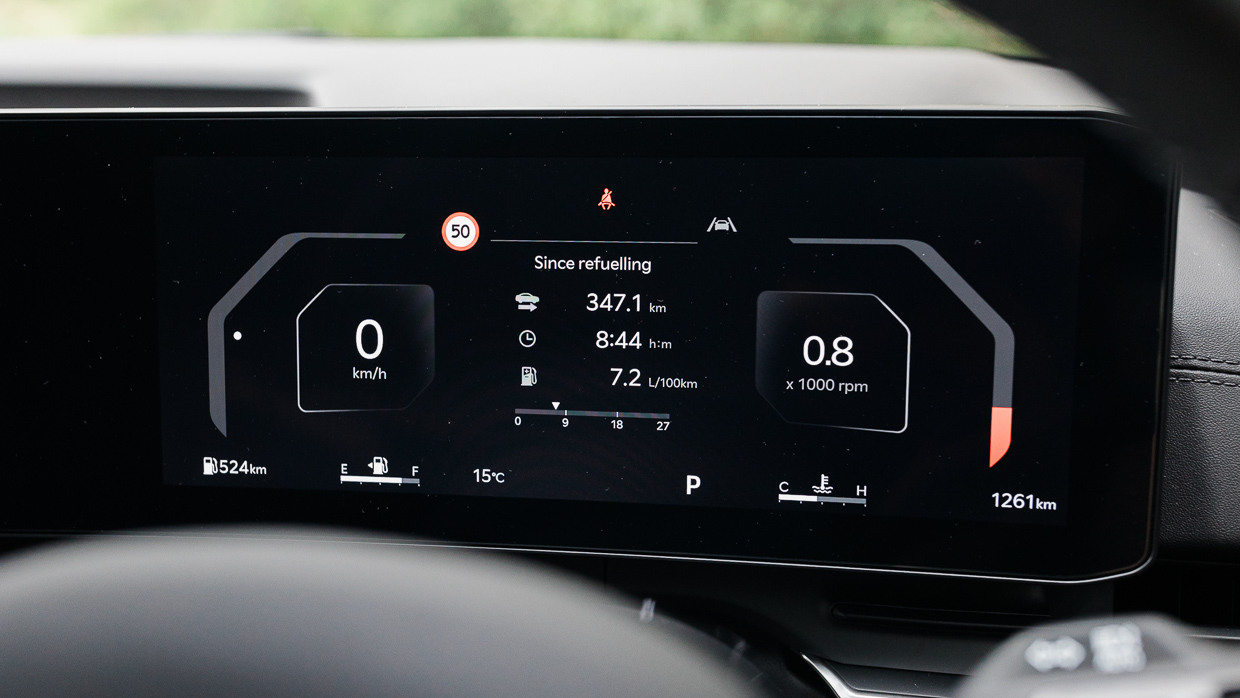
Turbo-petrol Hybrid versions of the Carnival will require shorter 10,000km intervals between maintenance visits. Kia projects capped price servicing will run at “around $400 per visit”.
During our time with Carnival we saw circa 10L/100km for the 3.5L petrol and around 7.0L/100km for the 2.2L diesel during identical real-world combined driving assessment.
The facelifted Carnival seems like a lineup of two halves and with vastly unequal sides.
On one side sits ten variants where you can have any one of five different variant tiers in a choice of two engines – a formula that’s served handsomely enough pre-facelift.
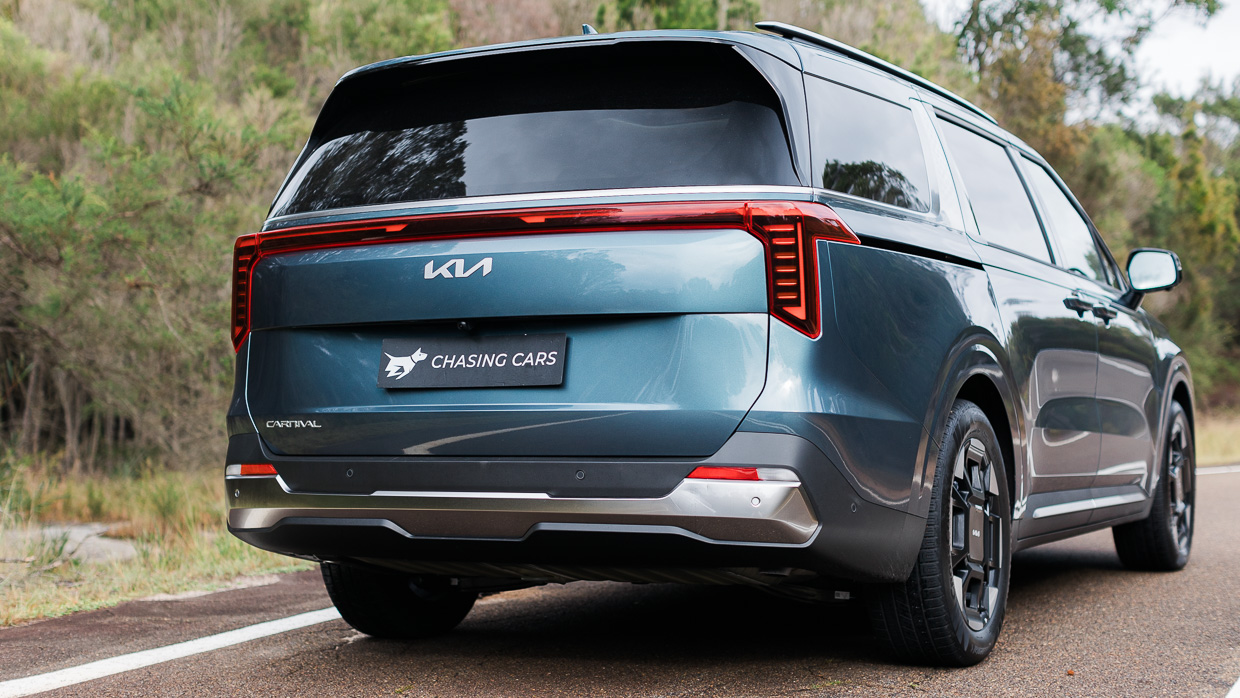
On the other, we have a new and undriven/unproven hybrid powertrain in a single, range-topping GT-Line variant at a $3300 premium over the hugely popular and proven diesel twin.
It’s a little disappointing that the turbo hybrid isn’t (yet) offered throughout the range like the 3.5L and 2.2L diesel are. With movement on the New Vehicle Efficiency Standard front, you can bet that this will likely be inevitable if, right now, not strictly necessary.
Whatever the case, the jury is firmly out on the only hybrid Carnival and one that wants for around $80K on road.
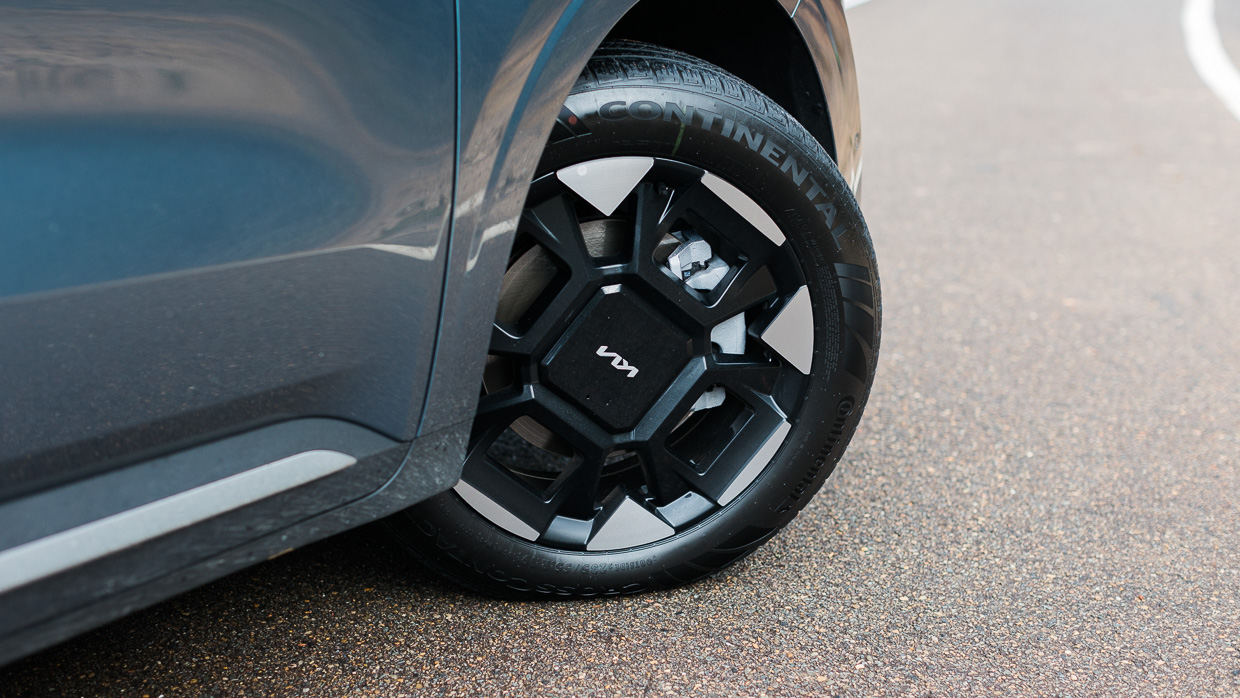
As for the other ten variants, the facelift marks happy days. The more contemporary makeover is welcome, the fresher tech is appealing, and the moderate price rise looks a fair and reasonable trade. The powertrains are proven and the new ride and handling improvements make the facelift an easy preference over the outgoing lineup.
What’s crucial is that Kia hasn’t messed with the basic ingredients or the recipe that’s made fourth-gen Carnival a critical and commercial success. It should not be lost that whatever variant you choose, you get the same brilliant packaging, the same improved suspension and steering, and the same powertrain spec undiluted.
We’d certainly recommend the diesel as our pick. But, alternatively, the petrol V6 is still fine enough. So it’s really a case of choosing your preferred motivational foil and then simply match the variant trim to your available budget. Too easy.
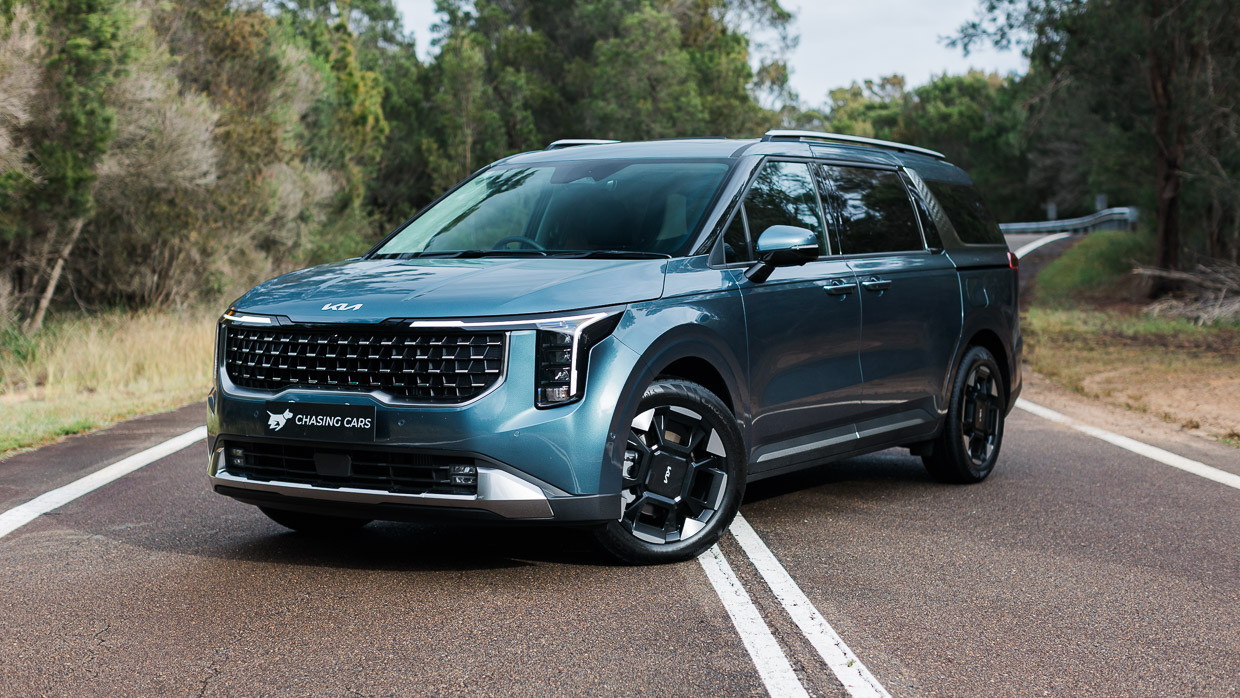
Through that lens, it really is hard to go wrong with the ‘carryover’ Carnival crop. In fact, we reckon you don’t commit to any mainstream seven-seat SUV before at least considering this excellent eight-seat MPV package and what it brings to the game of serious family hauling.
Further, we’re keen to see if the hybrid version can lift the breed’s game to the lofty place in the hierarchy to where it’s currently positioned.
Key specs (as tested)
About Chasing cars
Chasing Cars reviews are 100% independent.
Because we are powered by Budget Direct Insurance, we don’t receive advertising or sales revenue from car manufacturers.
We’re truly independent – giving you Australia’s best car reviews.
The estimate provided does not take into account your personal circumstances but is intended to give a general indication of the cost of insurance, in order to obtain a complete quote, please visit www.budgetdirect.com.au. Estimate includes 15%^ online discount.
^Conditions Apply
Budget Direct Insurance arranged by Auto & General Services Pty Ltd ACN 003 617 909(AGS) AFSL 241 411, for and on behalf of the insurer, Auto & General Insurance Company Limited(ABN 42 111 586 353, AFSL 285 571).Because we don’t know your financial needs, we can’t advise you if this insurance will suit you. You should consider your needs and the Product Disclosure Statement before making a decision to buy insurance. Terms and conditions apply.
Indicative quote based on assumptions including postcode , 40 year old male with no offences, licence suspensions or claims in the last 5 years, a NCD Rating 1 and no younger drivers listed. White car, driven up to 10,000kms a year, unfinanced, with no modifications, factory options and/or non-standard accessories, private use only and garaged at night.
^Online Discounts Terms & Conditions
1. Discounts apply to the premium paid for a new Budget Direct Gold Comprehensive Car Insurance, Third Party Property Only or Third Party Property, Fire & Theft Insurance policy initiated online on or after 29 March 2017. Discounts do not apply to optional Roadside Assistance.
2. Discounts do not apply to any renewal offer of insurance.
3. Discounts only apply to the insurance portion of the premium. Discounts are applied before government charges, taxes, levies and fees, including instalment processing fees (as applicable). The full extent of discounts may therefore be impacted.
4. We reserve the right to change the offer without notice.